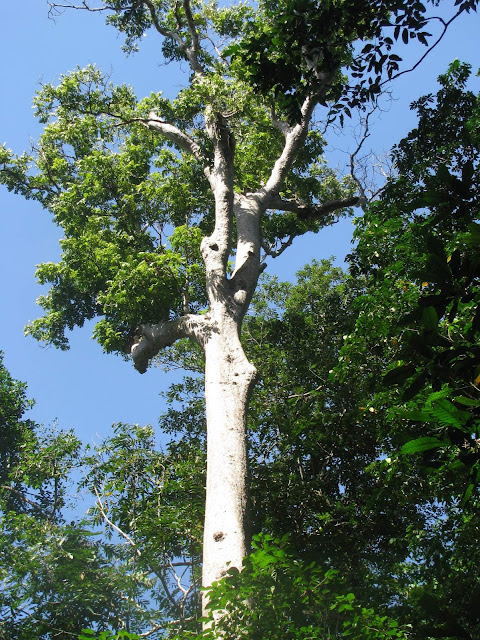Posted by Stuart Marsden and Simon Valle
We have just returned from a workshop dedicated to the conservation management of the Citron-crested Cockatoo on the Indonesian island of Sumba. It is 23 years since Stu last visited the island of Sumba in Indonesia. Then, in 1989 and again in 1992, he spent several months collecting data for his PhD on Indonesian parrots and hornbills.
 |
| The Critically Endangered Citron-crested Cockatoo Cacatua sulphurea citrinocristata (Photo: Peter Widman) |
On both occasions, he was working as part of Martin Jones’ Manchester Indonesian Islands Expedition team, itself a winner of the BP Conservation awards (the predecessor of the CLP Programme outlined in the last blog post on Colombian birds). While the main aim of the expedition was to assess forest quantity and quality and examine distribution, abundance and habitat associations of the island’s endemic birds (e.g. Jones et al. 1995; Jones et al. 2003), his primary job was to collect data on the islands five parrots and the endemic Sumba Hornbill Rhyticeros everetti.
 |
| Large numbers of Citron-rests left the island in the 1980s (1992 Photo: Stu) |
 |
| These are the trees. Large trees of just a few species are absolutely crucial for the survival of Sumba's hole-nesting birds (Photo: Stu) |
It appears that our efforts were timely and in 1992, there was a moratorium in trade in Citron-crests on Sumba. Of course, small numbers continued to appear in trade illegally during the 1990s but the reality was that the volume of trade was greatly reduced.
 |
The workshop
Thirteen years on, and again there is concern for the cockatoo. There are anecdotal reports from a ZGAP-funded project suggesting that the cockatoo is declining again, in spite of years of awareness work, which is believed to have just about stopped illegal trade in the cockatoo. Low breeding output, perhaps by an ageing population, is one factor suspected by some. This prompted both the Fonds für bedrohte Papageien-funded Sumba Cockatoo workshop and the new population study that Simon Valle and I plan for next year.
 |
| 2015 Sumba Cockatoo workshop participants, with organiser Thomas Arndt at the back, next to Simon |
Burung Indonesia (the BirdLife Partner) and Thomas Arndt organised for many people who have, are, or will be working on the Sumba Cockatoos, to meet near Waikabubak and confer about the conservation of the species. Participants ranged from the Burung Indonesia Sumba Team, who have been implementing an effective awareness programme for the last 10 years, to rangers from both of Sumba’s National Parks, to Anna Reuleaux, a biologist who has just started a one-year ZGAP-funded field research on the cockatoo’s breeding biology. The week-long workshop benefited hugely from the contribution of Thomas Arndt, ZGAP delegate and parrot expert, as well as of Peter and Indira Widman of the Katala Foundation who run the Philippine Cockatoo Conservation Programme, surely one of the most successful parrot conservation programmes in the world.
 |
| One of my greatest conservation heroes - Peter Widman who, along with Indira Lacerna-Widman, run the Katala foundation in the Philippines (Photo: Stu) |
Two main priorities were discussed - the need for a reliable population estimate, and the necessity of finding, surveying and protecting a sizable number of nests. Methods and results of previous surveys were analysed in order to identify possible issues and a new survey was devised (to be carried out from next April) in order obtain a reliable estimate of the current population size. We quickly realised how very little is known about their breeding productivity, and the factors that might affect it. This will be the focus of intensive fieldwork by Benny and the Burung team assisted by Anna in the next months.
 |
| Cockatoo pair visiting nest tree (Photo: Peter Widman) |
The workshop was a valuable opportunity to share the latest information on the species as well as some theoretical and practical knowledge on the most effective population survey and nest monitoring techniques. Finally there were promising talks with the staff from both the national parks about putting in place a regular long term monitoring scheme for the cockatoos implemented by park rangers.
References
Cahill, A.J., Walker, J.S. & Marsden, S.J. (2006). Recovery within a population of the Critically Endangered citron-crested cockatoo Cacatua sulphurea citrinocristata in Indonesia after 10 years of international trade control. Oryx 40: 161-167.
Jones M.J., Linsley, M.D. & Marsden, S.J. (1995). Population sizes, status and habitat associations of the restricted range bird species of Sumba, Indonesia. Bird Conservation International 5: 21-52.
Jones, M.J., Marsden, S.J. & Linsley, M.D. (2003). Effects of habitat change and geographical variation on the bird communities of two Indonesian islands. Biodiversity and Conservation 12: 1013-1032.
Marsden, S.J. (1999). Estimation of parrot and hornbill densities using a point count distance sampling method. Ibis 141: 377-390.
Marsden, S.J. & Jones, M.J. (1997). The nesting requirements of the parrots and hornbill of Sumba, Indonesia. Biological Conservation 82: 279-287.
Walker, J.S, Cahill, A.J. & Marsden, S.J. (2005). Factors influencing nest-site occupancy and low reproductive output in the Critically Endangered Yellow-crested cockatoo Cacatua sulphurea on Sumba, Indonesia. Bird Conservation International 15: 347-360.













